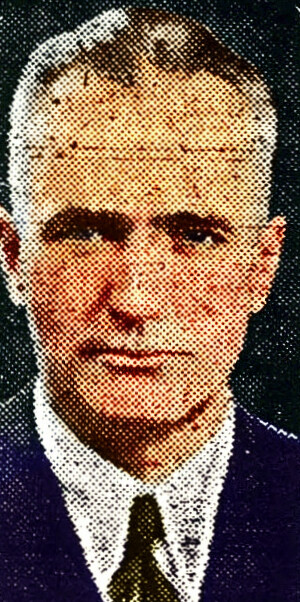For Immediate Release
March 15, 1945
IWO JIMA, Volcano Islands (March 14, delayed) – With the rattle of musketry to the north, where the remnants of the Japanese garrison force were being exterminated by Marines, faintly audible, the United States government today officially took possession of this desolate but strategic island on the road to Tokyo.
It did so in a proclamation issued by FADM Chester W. Nimitz, Commander in Chief of the Pacific Fleet and Pacific Ocean Areas and military governor of the Volcano Islands. After the proclamation had been read, the American flag was officially raised over the island.
The ceremony, held in the shadow of Suribachi, extinct volcano at the southern tip of Iwo, and attended by high-ranking officers of the Marine Corps, Navy and Army, was marked by simplicity.
Deep-throated roars of nearby Marine field pieces drowned the voice of Marine Col D. A. Stafford, of Spokane, Washington, V Amphibious Corps personnel officer, as he read the words suspending all powers of government of the Japanese Empire on the island.
The Stars and Stripes were run up on a staff atop a strongly reinforced Japanese bunker with an anti-aircraft gun emplacement above it. The military notables formed in rank on one side of the staff. On the other, an honor guard composed of eight military policemen from each of the three divisions that participated in the seizure of the island, was drawn up.
Among the military and naval leaders who planned and executed the invasion were: VADM Richmond Kelly Turner, USN, Commander, Amphibious Forces, Pacific; RADM Harry Hill, USN, of Oakland, California, deputy commander of the attack force; LtGen Holland M. Smith, Commanding General of the Fleet Marine Force of the Pacific; MajGen Harry F. Schmidt, V Amphibious Corps Commander; MajGen Graves B. Erskine, of La Jolla, California, 3rd Marine Division commander, and his chief of staff, Col Robert E. Hogaboom, of Vicksburg, Mississippi; MajGen Clifton B. Cates, 4th Marine Division Commander, and his chief of stag, Col M. J. Batchelder; and MajGen Keller Rockey, 5th Marine Division Commander, and his chief of staff, Col Ray A. Robinson. The Army was represented at the ceremony by MajGen James E. Chaney.
While Marine PFC John E. Glynn (309599), 21, of 2319 Humanity Street, New Orleans, Louisiana, veteran of Guadalcanal, sounded “Colors,” Old Glory was sent fluttering in the breeze to the top of the flagstaff by Marine PFC Thomas J. Casale (411750), 20, of (no street address) Herkimer, New York, and Albert B. Bush (437298), 24, of 16712 Woodbury Avenue, Cleveland, Ohio. Marine Sgt Anthony C. Yusi (285607), 25, of 68 Grove Street, Port Chester, New York, was in charge of the color detail.
The bugler and the color detail were chosen from the V Amphibious Corps Military Police Company. Their commanding officer, 1Lt Nathan R. Smith, of Whitehaven, Pennsylvania, said the men had been selected for general efficiency and military bearing. Both Yusi and Bush took part in the seizure of Saipan and Tinian in the Marianas. Moreover, Yusi was serving aboard the USS WASP (CV-7) when she was sunk by the Japs September 15, 1943.
The proclamation was the first issued by FADM Nimitz as military governor of the Volcano Islands. It was addressed, in Japanese as well as English, to the people of the islands. It read:
I, Chester William Nimitz, Fleet Admiral, United States Navy, Commander in Chief of the United States Pacific Fleet and Pacific Ocean Areas, do hereby proclaim as follows:
United States Forces under my command have occupied this and other of the Volcano Islands.
All powers of government of the Japanese Empire in the islands so occupied are hereby suspended.
All powers of government are vested in me as Military Governor and will be exercised by subordinate commanders under my direction.
All persons will obey promptly all orders given under my authority. Offenses against the Forces of Occupation will be severely punished.
Given under my hand at Iwo Jima this fourteenth day of March, 1945.
The ceremony took place as the battle for Iwo Jima entered its 24th day. The stubborn Japanese defenders had been driven northward to the end of the island.
The enemy was still defending his caves and bunkers to the death.
As the official flag was raised, the one that had flown over Suribachi since the fifth day of the battle was lowered. The Stars and Strips had been planted on the volcano by the Marines who wrested it from the Japs.
The place selected for the official flag is just off the beach in the southwestern section of the island. Selection of the site was prompted by convenience and the height of the ground.
Several hundred dirty, bearded and weary Marines working and bivouacked in the vicinity gathered to witness the brief ceremony, which required less than 10 minutes. They, as well as the participants, came smartly to attention and saluted while the bugler was sounding colors.
